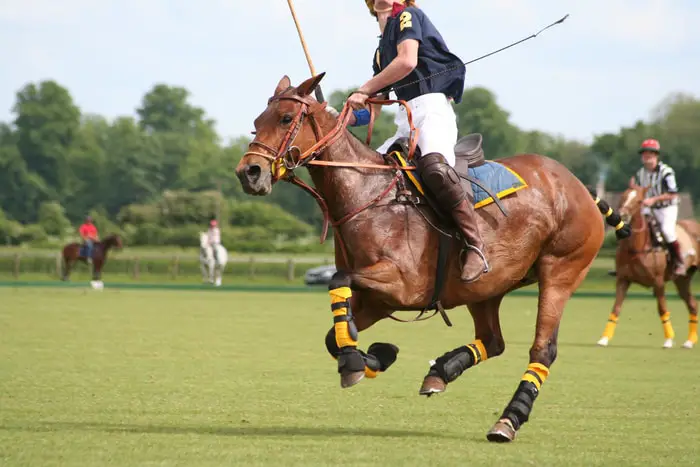Last Updated on December 14, 2021
Have you ever heard tying up in horses, and have no idea what they were talking about? Or maybe you thought they were actually talking about tying their horse up to something!
Don’t worry, you’re not alone! The phrase “tying up” actually references a few different syndromes in sport horses. These syndromes result in the horse’s muscles “tying up” or almost locking in place.
While tying up is not a new problem, lots of new research has been conducted and is still being conducted by vets to help understand what causes it and what can be done to help it. In this article, I’ll be discussing what happens when a horse ties up, why horses may tie-up, what to do when your horse ties up, and what you can do to prevent your horse from tying up.
What is Tying-Up in Horses?
Tying up is technically called “exertional rhabdomyolysis.” The American Association of Equine Practitioners describes tying up in the following words: “…what was considered by some early researchers to be a problem that had one basic cause, e.g. lactic acid, is actually a broad-scale syndrome that will require continued research on a variety of fronts before every aspect is understood. In other words, tying-up is not one disease, but several different diseases that have similar signs and different causes. Therefore, the management of a Thoroughbred that suffers from tying-up would differ from the management of a Quarter Horse that is tying-up, would differ from the management of a backyard pleasure horse that has the same symptoms.”
They also list some typical symptoms of tying up to be sweating, stiffness, and reluctance to any kind of activity. Other symptoms include increased heart rate, pawing, and sometimes bulging muscles.
Have you ever had a muscle lock up when you’re at the gym, or when you’re riding? Or had terrible lactic acid after a really hard workout, and it seems more painful just to move? These are similar to what horses feel when they are tying up.
There are loosely two types of tying up: sporadic and chronic. Sporadic tying up is when a horse might tie up from time to time due to excessive levels of exercise or lack of electrolytes. In contrast, chronic typing up is when a horse ties up regularly, and it isn’t necessarily triggered by a common condition.
Treatment and prevention look different for every horse, but especially between horses that experience sporadic and chronic tying up.
Why Does it Happen?
The reasons for tying up also depend on what type of tying up a horse is experiencing. If a horse has sporadic tying up, the cause for the tying up can typically be traced back to one or two things.
Depending on the horse, these things can include excessive exercise (over the amount that the horse is accustomed to), lack of electrolytes (think Gatorade), heat exhaustion, fatigue, extreme nervousness, dehydration, mineral deficiencies, and hormone imbalances.
Alternatively, if a horse has chronic tying up, the cause for tying up is unfortunately as simple as genetic inheritance. Sometimes horses with chronic tying up can be triggered by certain circumstances, such as overwork, but it is common for them to also tie-up with no trigger or reasoning.
What Can I Do When it Happens?
Once your horse starts tying up, unfortunately, there’s not much that can be done besides waiting for it to pass. If your horse starts showing symptoms of tying up during training, stop all training and exercise immediately.
Make sure your horse is in a safe environment where he won’t be likely to hurt himself, and call your vet. Offer your horse water, preferably water that has added electrolytes. Try to keep your horse calm and as comfortable as possible.
If your horse has a stall, his stall will likely be where he is most comfortable. You can also run a hot or cold (depending on the season) wet sponge over the affected muscles if you think this will help your horse relax.
If your horse has been known to tie up in the past, then the diagnosis should be easy. But, if this is new for your horse, there are lots of different things your vet will probably want to do. According to SmartPak, some of these things could include “…physical examination, bloodwork, muscle biopsy, and possibly other tests.”
What Can I Do to Prevent Tying Up in Horses?
While there isn’t much you can do to help your horse after he starts tying up, there are plenty of things that you can do to prevent him from tying up in the first place. As always, every horse is different and will respond differently to each method.
One popular way to help with tying up is through dietary changes. Restricting a horse to certain types of grain or feeding a horse certain supplements may help. Hygain Feeds produces its Hygain Release product specifically to help horses that tie up!
They say that horses that tie-up should be on a very small amount of grain, good quality hay, calming supplements, and a good balance of electrolytes. They also say that if the specialized grain is not an option, the grain with the lowest sugar and starch levels will be best.
The famous supplement manufacturer, SmartPak, also has some dietary recommendations. They recommend that horses inclined to tie up should be on a Chromium or Magnesium supplement, or some supplement that includes a mix of the two.
Vets will sometimes prescribe anti-inflammatory medications, such as bute (Phenylbutazone), for horses that have had a severe case of tying up.
Outside of these things, you need to make sure your horse is experiencing as little stress as possible. Make sure he is getting lots of turnouts, make sure his turnout situation or stalling situation doesn’t give him any stress or anxiety and make sure he always has access to water and always has something to snack on (typically hay).
The best advice I can give you is to know your horse. Know what stresses your horse out, and do your best to prevent these things from happening.
Conclusion
Tying up can be scary, especially if it is your horse’s first time. And, it can be scary because there is no one specific cure. But, it can be treated. Every horse is different, and every horse will react to treatments differently.
But, there are things you can do to help. I hope this article helped you learn more about tying up in horses. If so, please share this article, and share with us your experience with horses tying up!
FAQs
How long does it take for a horse to recover from tying up?
Recovery time for horses that suffer from episodes of "tying up" is between 6 and 8 weeks, and the return to work may depend on the severity of the problem. The first sign that a horse is recovering from tying up is when the horse moves his head normally.
There is no "cure" for horses that have chronic episodes of tying up, but it is possible to significantly decrease the number and severity of attacks. Some horses can be managed successfully with strict exercise, dietary and management protocols.
A horse with frequent, severe or chronic episodes of tying up should be managed by a veterinarian. The most common problem is muscle damage due to excessive use of muscles in the neck and back, as well as inflammation and swelling. Tying up is usually caused by over-exertion of the horse’s back or neck muscles and is commonly seen in young horses or those that have not been properly trained. Tying up is a condition where the horse becomes unable to move its head and neck. It is a common problem in horses that are ridden for long periods, especially if they are ridden hard on a daily basis. Some horses that tie up have a genetic predisposition to the condition. Horses that tie up can be very uncomfortable and usually feel sore for several days.
Should you walk a horse that is tying up?
When the horse is tying up, it should be walked on short, gentle circles, which will help keep the horse moving. It is recommended that the horse be walked slowly (at least 3 miles/hour), for at least 30 minutes at a time, until the horse stops tying up.
The horse should be walked only in an area where there are no other horses or people, and where the ground is soft enough to allow the horse to move easily. If you have a riding ring in your yard, use it instead of walking the horse in the pasture. A horse that is tying up can become agitated and start to kick and buck.
What to feed a horse that ties up?
Yet another reason why we need to be able to identify a horse's nutritional needs! A horse that has frequent episodes of tying up may not eat properly or may be underweight. This condition usually occurs when the horse is overworked or does not get enough exercise. When the horse is tied up, it can be difficult for the horse to eat, as its head and neck are usually restrained. It is recommended that a horse be fed a high-energy diet, such as a high-protein, high-carbohydrate diet. The horse should be fed small amounts frequently, with some type of energy rich food.
Does alfalfa cause tying-up?
In brief, no. Alfalfa has been used in horses for thousands of years for both therapeutic and preventive purposes. Alfalfa is a nutritious and easily digested plant which provides essential nutrients for horses and other animals. It contains calcium, phosphorus, magnesium, potassium, zinc, iron, and vitamins A, C, D and E. In addition to these benefits, alfalfa is known to reduce inflammation, promote muscle growth, and increase the production of red blood cells. The most common use of alfalfa in horses is as a pre-harvest preventative measure. Alfalfa is commonly fed to horses during the grazing season in order to help prevent the development of a condition called "foot rot".
Michael Dehaan is a passionate horse owner, horse rider, and lover of all things equine. He has been around horses since he was a child, and has grown to become an expert in the field. He has owned and ridden a variety of horses of different breeds, and has trained many to compete in shows and competitions. He is an experienced horseman, having worked with and competed many horses, including his own. He is an active member of the equestrian community, participating in events and teaching riding lessons.


